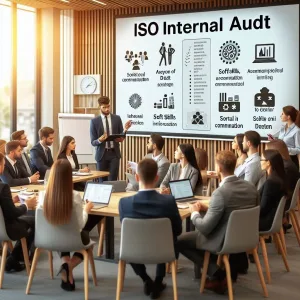In today’s rapidly evolving work environment, the concept of access control audits has gained significant importance, particularly in the context of remote work. An access control audit is a systematic evaluation of an organization’s access control systems, which includes reviewing user permissions, identifying inactive accounts, and assessing the overall effectiveness of security measures. This process is crucial for ensuring that sensitive information is only accessible to authorized individuals, thereby safeguarding organizational assets and maintaining compliance with various regulatory standards [1][8].
The rise of remote work, accelerated by global events and technological advancements, has transformed the traditional workplace. While this shift has provided flexibility and increased productivity for many employees, it has also introduced new vulnerabilities to organizational security. With employees accessing company resources from various locations and devices, the risk of unauthorized access and data breaches has escalated. Organizations must now navigate the complexities of securing their information systems while accommodating a dispersed workforce [13][15].
As remote work becomes a permanent fixture for many organizations, the challenges associated with access control audits have also evolved. Internal auditors and HR professionals face unique hurdles, such as ensuring that access permissions align with current job responsibilities, managing the dynamic nature of remote access, and maintaining compliance with security policies across diverse environments. These challenges necessitate a proactive approach to access control audits, emphasizing the need for regular reviews and updates to access rights and security protocols [8][12].
In this blog, we will delve deeper into the intricacies of access control audits in the age of remote work, exploring best practices and strategies to enhance security and compliance in this new landscape.
Understanding Access Control Audits
In today’s increasingly digital landscape, particularly with the rise of remote work, access control audits have become a critical component of organizational security. These audits are essential for ensuring that sensitive information remains protected and that compliance with various regulations is maintained.
What is Access Control?
Access control refers to the mechanisms and policies that govern who can access specific resources within an organization. It encompasses three primary components:
- Authentication: This is the process of verifying the identity of a user or system. It often involves methods such as passwords, biometrics, or two-factor authentication to ensure that only authorized individuals can gain access to sensitive information.
- Authorization: Once a user is authenticated, authorization determines what resources they can access and what actions they can perform. This is typically managed through various models, such as Role-Based Access Control (RBAC), where access rights are assigned based on the user’s role within the organization.
- Accountability: This component ensures that actions taken within the system can be traced back to the individual who performed them. It involves logging access activities and monitoring user behavior to detect any unauthorized actions or breaches.
Objectives of Access Control Audits
Access control audits serve several key objectives that are particularly relevant in the context of remote work:
- Ensuring Compliance: Organizations must adhere to various regulatory frameworks, such as GDPR, HIPAA, and others, which mandate strict access control measures. Audits help verify that these compliance requirements are being met, thereby reducing the risk of legal penalties.
- Identifying Vulnerabilities: Remote work environments can introduce unique vulnerabilities, such as insecure home networks or personal devices accessing corporate resources. Access control audits help identify these weaknesses, allowing organizations to implement necessary remediation measures to enhance security.
- Protecting Sensitive Information: With the increase in remote access to sensitive data, it is crucial to ensure that only authorized personnel can access this information. Audits help assess the effectiveness of current access controls and recommend improvements to safeguard sensitive data from potential breaches.
The Role of Internal Auditors
Internal auditors play a vital role in conducting access control audits. Their responsibilities include:
- Evaluating Access Control Policies: Auditors review existing access control policies and procedures to ensure they are effective and aligned with organizational goals and compliance requirements.
- Assessing Authentication and Authorization Mechanisms: They examine the strength of authentication methods and the appropriateness of authorization levels to ensure that access is granted based on necessity and job functions.
- Monitoring and Reporting: Internal auditors monitor access logs and user activities to identify any anomalies or unauthorized access attempts. They also provide reports to management, highlighting areas for improvement and recommending best practices for access control.
Access control audits are essential for organizations, especially in the age of remote work. They not only help ensure compliance and protect sensitive information but also empower internal auditors to play a proactive role in safeguarding organizational assets. By understanding the components and objectives of access control audits, HR professionals and internal auditors can better navigate the challenges posed by remote working environments.
Challenges of Remote Work on Access Control
The shift to remote work has transformed the landscape of internal auditing, particularly in the realm of access control. As organizations adapt to this new normal, several unique challenges have emerged that HR professionals and internal auditors must navigate to ensure robust security measures are in place. Here are some of the key challenges posed by remote working environments:
- Increased Use of Personal Devices and Shadow IT: With employees working from home, there is a significant rise in the use of personal devices for work-related tasks. This trend often leads to the phenomenon known as “shadow IT,” where employees utilize unauthorized applications and services that may not comply with the organization’s security policies. This creates vulnerabilities, as personal devices may lack the necessary security controls, making it difficult for auditors to ensure that access to sensitive information is properly managed and monitored [5][10].
- Difficulty in Monitoring User Behavior and Access Logs: In a remote work setting, tracking user behavior and access logs becomes increasingly challenging. Traditional monitoring tools may not be as effective when employees are dispersed across various locations. This lack of visibility can hinder the ability to detect unauthorized access or unusual activities, which are critical for maintaining the integrity of access control systems. Auditors must find innovative ways to enhance monitoring capabilities to ensure compliance and security [8].
- Challenges in Ensuring Secure Remote Connections and Data Transmission: The reliance on virtual private networks (VPNs) and other secure connection methods is essential for protecting data transmitted over the internet. However, ensuring that these connections are secure can be complex, especially when employees are using different networks with varying levels of security. Internal auditors need to assess the effectiveness of these security measures and ensure that data transmission remains protected against potential breaches [12][15].
- Risks Associated with Remote Team Collaboration Tools and Platforms: The use of collaboration tools has surged as teams work remotely, but these platforms can introduce significant risks if not properly managed. Many collaboration tools may not have robust security features, making them susceptible to data leaks and unauthorized access. Auditors must evaluate the security protocols of these tools and ensure that employees are trained on best practices to mitigate risks associated with remote collaboration [11][14].
The transition to remote work has introduced a myriad of challenges for access control in internal auditing. By understanding these challenges, HR professionals and internal auditors can develop strategies to enhance security measures, ensuring that access to sensitive information remains tightly controlled and monitored in this evolving work environment.
Best Practices for Conducting Access Control Audits Remotely
In the evolving landscape of remote work, conducting access control audits presents unique challenges that require innovative strategies. Here are some actionable best practices for HR professionals and internal auditors to effectively manage access control audits in a remote setting:
- Utilize Automated Tools for Real-Time Monitoring and Reporting: Implementing automated tools can significantly enhance the efficiency of access control audits. These tools allow for continuous monitoring of user access and can generate real-time reports, making it easier to identify unauthorized access or anomalies. Automation reduces the manual workload and increases the accuracy of the audit process, ensuring that any potential security breaches are detected promptly [11].
- Implement Regular Training Sessions for Employees on Security Protocols: Regular training is essential to ensure that employees are aware of the latest security protocols and best practices. Conducting training sessions can help reinforce the importance of access control measures and educate staff on recognizing potential security threats. This proactive approach not only enhances compliance but also fosters a culture of security awareness within the organization [10].
- Adopt a Risk-Based Approach to Prioritize Critical Systems and Data: In a remote work environment, it is crucial to adopt a risk-based approach when conducting access control audits. This involves identifying and prioritizing critical systems and sensitive data that require heightened security measures. By focusing on the most vulnerable areas, auditors can allocate resources effectively and ensure that the most significant risks are addressed first.
- Ensure Clear Documentation of Access Rights and Changes Over Time: Maintaining clear and comprehensive documentation of access rights is vital for effective access control audits. This includes tracking changes in access permissions and ensuring that there is a clear record of who has access to what information. Regularly updating this documentation helps in maintaining accountability and provides a reliable reference during audits.
By implementing these best practices, HR professionals and internal auditors can navigate the complexities of access control audits in a remote work environment, ensuring that security measures are robust and effective.
Leveraging Technology for Enhanced Access Control
In today’s increasingly remote work environment, organizations face unique challenges in maintaining robust access control measures. As HR professionals and internal auditors navigate these complexities, leveraging technology becomes essential for enhancing access control audits. Here are some key points to consider:
- Role of Identity and Access Management (IAM) Systems: IAM systems are critical in managing user identities and their access rights across various platforms. These systems help ensure that only authorized personnel can access sensitive information, which is particularly important in a remote work setting where employees may be accessing company resources from various locations. By implementing IAM solutions, organizations can streamline access control processes, enforce policies consistently, and maintain a clear audit trail of user activities [1][3].
- Importance of Multi-Factor Authentication (MFA): Multi-factor authentication adds an additional layer of security by requiring users to provide two or more verification factors to gain access to resources. This is especially vital in remote work scenarios where the risk of unauthorized access increases. MFA can significantly reduce the likelihood of security breaches, as it makes it more difficult for attackers to compromise accounts, even if they have obtained a user’s password [8][9].
- Use of Cloud-Based Solutions: Cloud-based access control solutions offer enhanced accessibility and security for remote workers. These solutions allow organizations to manage access rights and monitor user activities in real-time, regardless of the user’s location. By utilizing cloud technology, companies can ensure that their access control measures are scalable and adaptable to the changing needs of a remote workforce, while also benefiting from the latest security updates and features [6][7].
- Potential of AI and Machine Learning in Identifying Access Anomalies: Artificial intelligence (AI) and machine learning can play a transformative role in access control audits by analyzing user behavior and identifying anomalies that may indicate security threats. These technologies can help auditors detect unusual access patterns, such as logins from unfamiliar locations or at odd hours, enabling proactive responses to potential breaches. By integrating AI-driven analytics into access control systems, organizations can enhance their ability to safeguard sensitive information and maintain compliance with security policies [12][14].
As remote work continues to shape the landscape of organizational operations, embracing technology in access control audits is crucial. By focusing on IAM systems, MFA, cloud solutions, and AI capabilities, HR professionals and internal auditors can effectively address the challenges posed by remote environments and strengthen their organization’s security posture.
Conclusion
In the evolving landscape of remote work, access control audits have become more critical than ever. The unique challenges posed by this environment include:
- Increased Vulnerability: With employees accessing sensitive information from various locations and devices, the risk of unauthorized access has escalated. This necessitates a robust framework to ensure that only authorized personnel can access critical data.
- Diverse Access Points: Remote work often involves multiple access points, including personal devices and home networks, which can complicate the enforcement of consistent access control measures. This diversity can lead to gaps in security if not properly managed.
To address these challenges, organizations must adopt best practices and leverage technological tools that enhance access control. Key strategies include:
- Implementing Multi-Factor Authentication (MFA): This adds an extra layer of security by requiring users to provide two or more verification factors to gain access, significantly reducing the risk of unauthorized access.
- Regular Audits and Monitoring: Conducting frequent access audits helps identify inactive users, outdated permissions, and potential vulnerabilities. This proactive approach ensures that access rights are aligned with current roles and responsibilities.
- Utilizing Advanced Access Control Technologies: Tools such as Role-Based Access Control (RBAC) and context-based access controls can dynamically manage user permissions based on their roles and the context of their access requests.
As HR professionals and internal auditors navigate the complexities of remote work, it is essential to prioritize access control audits within their strategies. By doing so, they not only safeguard sensitive information but also foster a culture of security awareness among employees. Emphasizing the importance of these audits will help organizations maintain compliance with regulatory standards and protect their assets in an increasingly digital world.
Call to Action
As remote work becomes increasingly prevalent, organizations face unique challenges in maintaining robust access control measures. It is essential for HR professionals and internal auditors to proactively assess and enhance their access control audit processes to safeguard sensitive information and ensure compliance with regulatory standards. Here are some actionable steps to consider:
- Assess Current Access Control Measures: Begin by conducting a thorough review of your existing access control policies and procedures. Evaluate whether they effectively address the risks associated with remote work, such as unauthorized access and data breaches. Consider implementing regular user access audits to ensure that permissions align with current job responsibilities and that any temporary access is revoked promptly when no longer needed [9][10].
- Utilize Available Resources: To further strengthen your understanding and implementation of access control audits, explore various resources. Look for comprehensive guides that cover best practices, case studies, and future trends in access control, especially in the context of remote work [8]. Additionally, consider enrolling in training programs that focus on access management compliance with frameworks like NIST, GDPR, and HIPAA [4]. These resources can provide valuable insights and tools to enhance your audit processes.
- Engage with the Community: We invite you to share your experiences and strategies regarding access control audits in the comments section below. Discuss the challenges you’ve faced in remote environments and the solutions you’ve implemented. By exchanging ideas and best practices, we can collectively improve our approaches to access control and ensure a secure working environment for all employees.
Taking these steps will not only help you address the current challenges posed by remote work but also position your organization to better manage access control in the future. Let’s work together to create a safer and more compliant workplace.
Find out more about Shaun Stoltz https://www.shaunstoltz.com/about/
This post was written by an AI and reviewed/edited by a human.



